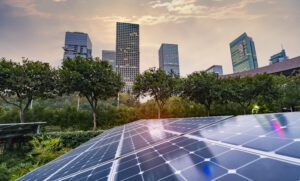On January 19th I was delighted to be invited to join a panel session at the World Future Energy Summit in Abu Dhabi to discuss how R&D and innovation could be key to a low carbon future.
The World Future Energy Summit (WFES) is an impressive event and I feel privileged to have been asked to speak. Now in its 8th year, the 2015 conference is expected to attract 30,000 delegates from 170 countries and is a significant annual event in the global energy conversation.
The WFES is held under the patronage of His Highness Sheikh Mohammed Bin Zayed Al Nahyan, Crown Prince of Abu Dhabi. The event aims to catalyse partnerships between leading companies representing the entire energy spectrum, from hydrocarbons to renewables, who gather to showcase innovations and share best practices.
The panel discussion I participated in gave me the opportunity to share my belief that innovation and R&D both have significant roles to play as societies move toward a low carbon future. The very fact that energy use is anticipated to grow by 40% in the next two decades suggests that innovation will be needed. However, innovation also poses risk, particularly as the future always holds a degree of uncertainty.
With this in mind, I believe we need to create an environment that will specifically foster original thinking and creativity. The hallmarks of such an environment would include the following:
- A clear commitment from leadership to maintain a focus on programmes which deliver innovation, throughout uncertain economic landscapes both in the short and longer term. A guaranteed commitment is vital to provide a stable environment in which innovation can flourish. As idealistic as it sounds, it’s important that such support extends beyond the tenure of a single term of government, and therefore politicians will need to give primacy to long term goals not short term election promises in order to secure our future. The sponsorship and patronage of leaders is a key metric.
- Additional customer benefits: Innovation is not an end in itself – it must deliver cost benefits such as lower operating expenses or increased flexibility in addition to reduced carbon emissions. Green benefits may not be enough on their own to persuade either corporate entities or individuals to invest in new solutions. Customer benefits that positively impact citizens, not only monetarily but also increasing quality of life will significantly enhance overall project success.
- Partnerships for innovation: achieving breakthroughs in technology and processes as a result of R&D will require a range of new partnerships. These will probably include commercial, financial and legal relationships to facilitate engagement in new ventures and technologies as they emerge. These partnerships should also, wherever possible, encompass public and private sector as well as academia, and may well require new models of engagement if they are to be successful.
- Supportive Government Policies can play a key role in creating an environment to enable commitments to developing Green House Gas reducing technologies.
- R&D is the heart of innovation: a thorough grasp and understanding of the issues, market drivers and problems people are seeking to solve are all vital components for establishing the opportunities to innovate. With respect to cities, R&D must primarily focus on the needs of citizens, and the demands they place on the municipalities and authorities who are trying to serve and support them.
It’s been said many timesa that the sort of thinking that will solve today’s problems will have to be of a different order to that which caused them in the first place. What I see through events like WFES is industry and governments coming together to try and look at things differently – which I applaud. But I suspect there are still some hard miles ahead.



Conversation
Great post Charbel, I agree new innovative partnerships will be key to overcoming the energy challenge we face and a willingness to take on risk would greatly contribute to this environment. When these partnerships look to innovate around new models for energy efficiency and conservation it will inevitably require that stakeholders step outside traditional project boundaries (and take on risk as you point out). Identifying new revenue streams and competitive differentiation in the space of energy management will be key to driving meaningful change – the partnerships that figure out the business models will make this change happen.
Hi Drew, Many thanks for your comment. Looks like we agree that successfully making the shift to smart cities will require new models. It’s an exciting challenge for sure and one that I find hugely motivating and rewarding. Thanks again.